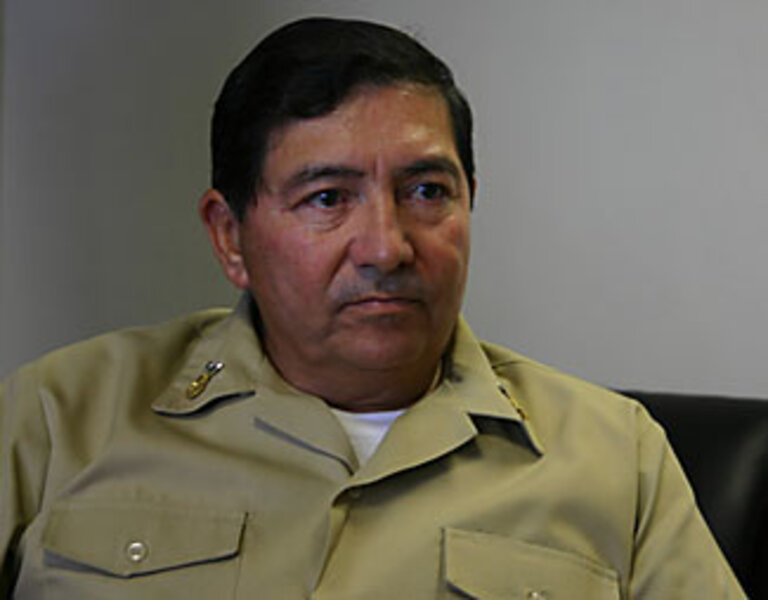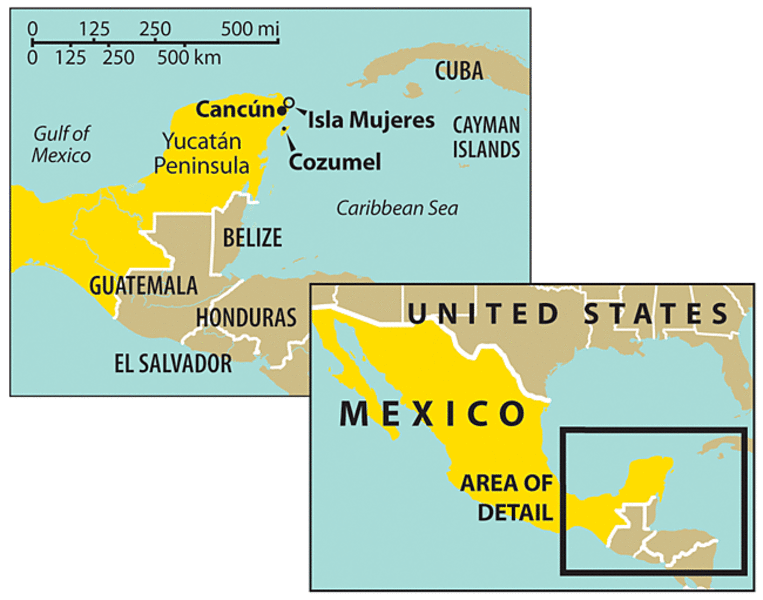New Cuban escape route: via Mexico
Loading...
| Isla Mujeres, Mexico
Cubans have a new route to the US – and it goes through Cancún.
As the US Coast Guard has beefed up patrols off Miami, more Cubans are fleeing to Mexico's Yucatán Peninsula, 120 miles west of Cuba's tip. From the Mexican resort area, smugglers take them north to the US border. Last year, more than 11,000 Cubans were caught crossing into the US from Mexico, twice the number caught in 2004.
It's also put pressure on Mexico. On a recent day, the Mexican Navy patrols the choppy turquoise waters off Isla Mujeres, where they've recently added picking up undocumented Cubans to their list of duties that already include interdicting drug smugglers and looking for boaters in distress. That's why Mexico's tightening its immigration rules.
Starting Nov. 20, Cubans found in Mexico will face immediate deportation.
"The option of repatriation will reduce the number of Cubans arriving in Mexico," says Luis Alberto Molina Rios, the director of the regional office in Cancun of the National Institute of Migration for the state of Quintana Roo. "Today they know that if they are caught here, within 30 days they can be in the US."
Migration route shifting
The flow of Cubans into the Miami area has shifted in recent years because of stricter controls by the US Coast Guard. During fiscal year 2008, for example, 2,199 Cubans were interdicted at sea, down from 2,868 the year before, says US Coast Guard Lt. Matthew Moorlag, public affairs officer for the 7th District in Miami.
He attributes the drop to stricter enforcement, including greater cooperation between various federal agencies. "We certainly have an increased patrol presence," Mr. Moorlag says.
With beefed up security, Cubans have been heading for Mexico's Yucatán Peninsula, just 120 miles west. And the easternmost island, Isla Mujeres, has been at the center of the new course, says Mr. Angulo Jimenez. In 2005, the Navy here intercepted 215 undocumented Cubans; that more than doubled to 480 last year.
Mexico is a logical destination for many Cubans because most caught here are simply fined and given up to 30 days to leave, says Mr. Molina Rios.
The head of the National Institute of Migration, Cecilia Romero, said that of 2,030 Cubans detained in Mexico from January through August, only 28 were returned home.
Most head north along the same routes that Mexicans and Central Americans have long taken in their attempts to get to the US. Yet unlike other immigrants, Cubans simply walk across the US border and apply for residency: under the "wet foot, dry foot" policy, those caught in US waters are sent home, while those who reach land are usually allowed to stay.
It's become so common that it's garnered a new phrase: "dusty foot." But now, under the new policy between Cuba and Mexico, the majority could be repatriated home, says Molina Rios.
This will likely reduce the flows of Cubans attempting to reach the US via Mexico, says Eduardo Matias Lopez, who founded the Cuban-Mexican Civic Association in Mexico City. "But in terms of corruption, that will only increase," he says.
Mr. Lopez says he fears it will embolden Mexican officials to seek higher bribes from Cubans trying to head north, and instead of punishing the corrupt, it will only hurt the poorest Cubans.
How Cubans arrive in Mexico
On Isla Mujeres, many undocumented immigrants arrive famished, having set off in homemade boats made of wood or aluminum.
Sometimes they spend up to a week at sea. But increasingly smugglers, who charge anywhere from $5,000 to $10,000, have joined the fold, says Cmdr. Angulo Jimenez, principally Cuban-Americans, he says. He points to more than a half-dozen high-powered boats bobbing in the Navy marina – one adorned with an American flag – that were stolen from Miami. This year they've recovered 20 such boats, up from five last year.
Cuban migrants tend to quickly depart from Isla Mujeres, disguising themselves as locals or tourists and taking the ferry service to Cancún.
Still, Sandra Herrera, a local store owner, says residents are worried that violence associated with human trafficking will find its way to their tranquil island, where residents walk carefree at any time of night.
Violence already has grabbed headlines in this region. This summer, in one of the most notorious cases, gunmen hijacked a government bus and took 33 Cubans on board.
Such mayhem has not reached Isla Mujeres but many fear it will. "We've never seen this before," Ms. Herrera says. "Now there are people driving fancy cars and walking around with thick [gold] chains. The violence could come here."
Andy Gomez, a senior fellow at the Institute for Cuban and Cuban-American Studies at the University of Miami, says that if the Coast Guard has more effectively intercepted rafts from Cuba it has not been able to diminish smuggling.
Traffickers have merely gone around the patrols. And he says the agreement between Mexico and Cuba will do the same: either shift the flow of people or lead to even more bribery and corruption. "I'm afraid this won't deter smuggling at all," he says. "It will be a challenge for Mexican authorities to implement it."
Indeed, Mexico has been a victim of the so-called "balloon effect" in the drug trade. Pressure on Colombia, for example, has shifted drug-trafficking routes into Mexico. Pressure on main drug factions has spread the power to smaller groups and fueled corruption.
The Cuban migration route is under a similar effect, says Moorlag. "It's kind of like a balloon," he says. "If you put pressure into the center of a balloon the air goes out. If we focus on a specific area, then generally smugglers will change their methods to be more successful."
Mexico's new policy signals a better relationship with Cuba – which had fallen to an all-time low during the presidency of Vicente Fox, when he condemned Cuba's human rights record at a UN meeting in 2002. The countries temporarily recalled their ambassadors in 2004.
But Omar Lopez, the human rights director at the Cuban American National Foundation in Miami, calls the policy contradictory on the part of Mexico. "Mexico has a long tradition of giving asylum to those escaping dictatorship in Latin America," he says.
But if it benefits the two countries diplomatically, it does little to help the people, says Julio, a Cuban who lives on Isla Mujeres and declined to give his last name.
He says he stole a boat a decade ago and arrived on the shores of Isla Mujeres, as so many of his compatriots are doing today. "Where do the people fit into this agreement?" he says. "As long as there is no hope, this kind of agreement does nothing for us."








